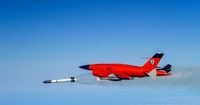On May 10, 2025, leaders from France, Germany, Poland, and the United Kingdom arrived in Kyiv, Ukraine, to express their united support for the nation amidst the ongoing conflict with Russia. This marked the first joint visit of these four leaders to Ukraine, where they met with President Volodymyr Zelenskyy. The visit comes at a crucial time as pressure mounts on Russia to agree to a 30-day ceasefire to facilitate negotiations for a lasting peace settlement.
The leaders emphasized their commitment to Ukraine, underscoring the importance of international sanctions against Russia and the need for enhanced cooperation among European and NATO allies. They plan to meet with defense industry leaders over the next month to expand collaboration, aiming to strengthen Ukraine's defense capabilities further. "We stand united in our support for Ukraine and call for an immediate ceasefire to pave the way for peace talks," said one of the officials during the visit.
As the situation continues to evolve, the leaders' presence in Kyiv serves as a powerful statement of solidarity. European and NATO allies are working together to bolster industrial capacity and support sanctions that open trade and promote industrial cooperation, which are vital for Ukraine's defense and recovery.
Meanwhile, the U.S. military is making strides in missile technology, having successfully tested solid fuel missiles launched from uncrewed aerial vehicles (UAVs). On May 11, 2025, the U.S. Navy's Naval Air Warfare Center Weapons Division (NAWCWD) reported that it has achieved a significant milestone by launching the first solid fuel rocket motor (SFIRR) from a UAV platform, specifically the BQM-34 UAV. This advancement is expected to enhance the flexibility of military operations, enabling missions in areas that are difficult for manned aircraft to access.
The SFIRR technology is designed to improve intelligence operations by allowing for more versatile targeting capabilities. The ability to launch missiles from UAVs not only ensures the safety of piloted aircraft and personnel but also opens new dimensions in tactical and strategic military engagements.
In addition to these developments, Poland is ramping up its military production capabilities. Huta Stalowa Wola (HSW), a Polish defense company, has signed a significant framework agreement with the Ministry of Defense to produce 1,400 Borsuk tracked armored vehicles. This initiative represents a crucial step in modernizing Poland's ground forces.
The Borsuk infantry fighting vehicle is a modern amphibious tracked vehicle developed jointly by HSW and Polska Grupa Zbrojeniowa. It is equipped with advanced features, including the ZSSW-30 turret, a 30 mm Bushmaster II cannon, and Spike-LR anti-tank missiles. The modular design of the Borsuk enhances its defense against various threats, including landmines and explosive devices, while its amphibious capabilities allow it to traverse Poland's numerous water bodies without assistance.
"The Borsuk project underscores our commitment to enhancing our national defense capabilities and ensuring the security of our borders," said a spokesperson for the Polish Ministry of Defense. This initiative not only supports Poland's military readiness but also reinforces the domestic defense industry, which has been investing heavily in advanced manufacturing technologies and research and development.
In a related development, Hanwha Aerospace, a South Korean defense company, has proposed supplying Tigon armored vehicles to Chile. This offer aligns with Chile's efforts to modernize its wheeled armored fleet under the CROMO program. Hanwha's proposal includes several base configurations, including 4x4, 6x6, and 8x8 variants, with a focus on technology transfer and joint production to bolster Chile's domestic defense capabilities.
The Tigon 4x4 variant weighs approximately 14 tons and features a modular design that allows for various configurations tailored to specific operational needs. The 6x6 version, weighing 21 tons, is powered by a 525 horsepower Caterpillar C9.3 engine, achieving a top speed of 110 km/h with an operational range of 800 km. It can carry up to 11 personnel and supports a range of weaponry, including 7.62 mm or 12.7 mm caliber weapons and a 30 mm caliber turret.
The Tigon 8x8 variant weighs between 32 and 34 tons, depending on its configuration, and is equipped with a 700 horsepower engine. It can reach speeds of up to 100 km/h and has a similar operational range of 800 km, accommodating 11 personnel. This version also supports various weapons systems, including a 30 mm automatic cannon and a 105 mm cannon, with high-level fire protection and mine protection capabilities.
As military advancements continue to shape the global landscape, the focus on enhancing defense capabilities underscores the importance of national security in an increasingly complex world. The developments in Ukraine, the U.S., Poland, and Chile reflect a broader trend of nations investing in their military infrastructure to safeguard their interests and respond to emerging threats.
As the international community watches closely, the implications of these military advancements will likely resonate far beyond their immediate geographic contexts, influencing global security dynamics in the years to come.

